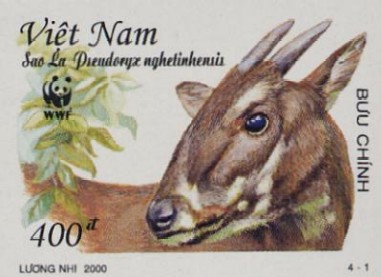
September 26, 2007

Eleven new species, including a snake and two butterflies, have been discovered in a remote region of Vietnam known as the ‘Green Corridor’, the WWF reveals Wednesday.
Five orchids and three other plants make up the rest of the haul of species new to science. They all appear to be unique to Vietnam’s Annamites mountain range.
Ten other plant species, including four orchids, are being examined to check whether they are also new to science. The area in Thua Thien Hue province is already renowned among conservationists following the discovery of several new large mammal species in the 1990s.
“You only discover so many new species in very special places, and the ‘Green Corridor’ is one of them,” said Chris Dickinson, chief technical adviser in the area for WWF (formerly the World Wide Fund for Nature).
“These latest discoveries could be just the tip of the iceberg.” The new snake species, called the white-lipped keelback, lives close to streams where it feeds on frogs and other small animals. Its body is covered with red spots and it sports a yellow-white strip on its head. It is about 80cm (32 ins) long.
Three of the new orchid species are entirely leafless and contain no chlorophyll. Rather than using the sun’s energy, they live on decaying matter, like many fungi. The other new plants include the Aspidistra nicolai, which has an almost black flower, and a new species of arum, the Cryptocoryne vietnamica, which has beautiful yellow flowers surrounded byfunnel-shaped leaves. The two new butterflies are among eight that have been discovered in the province since 1996.
Recent surveys have shown that the ‘Green Corridor’ is home to many threatened species, including 15 reptiles and amphibians and six bird species, as well as the greatest number of one of the world’s most endangered primates, the white-cheeked crested gibbon.
The area is also believed to be the best location in Vietnam to conserve the saola, a unique type of wild cattle only discovered by scientists in 1992. It is one of the last remaining lowland wet evergreen forests left in Vietnam.
But the charity says the area needs protection from human activities such as illegal logging, hunting, extraction of natural resources and development.
“The area is extremely important for conservation and the province wants to protect the forests and their environmental services, as well as contribute to sustainable development,” said Hoang Ngoc Khanh, Director of Thua Thien Hue provincial forest protection department.by James Randerson in London, Guardian New Service, “11 new species found in Vietnam’s Green Corridor,” September 26, 2007.
“Vietnam’s Green Corridor” was called “Vietnam’s Lost World” soon after the saola was discovered and in the years following other remarkable finds of large mammals. Clearly, it appears the work of Dr. Pamela D. McElwee on the use of the term “Lost World” has had an impact.
About Loren Coleman
Loren Coleman is one of the world’s leading cryptozoologists, some say “the” leading living cryptozoologist. Certainly, he is acknowledged as the current living American researcher and writer who has most popularized cryptozoology in the late 20th and early 21st centuries.
Starting his fieldwork and investigations in 1960, after traveling and trekking extensively in pursuit of cryptozoological mysteries, Coleman began writing to share his experiences in 1969. An honorary member of Ivan T. Sanderson’s Society for the Investigation of the Unexplained in the 1970s, Coleman has been bestowed with similar honorary memberships of the North Idaho College Cryptozoology Club in 1983, and in subsequent years, that of the British Columbia Scientific Cryptozoology Club, CryptoSafari International, and other international organizations. He was also a Life Member and Benefactor of the International Society of Cryptozoology (now-defunct).
Loren Coleman’s daily blog, as a member of the Cryptomundo Team, served as an ongoing avenue of communication for the ever-growing body of cryptozoo news from 2005 through 2013. He returned as an infrequent contributor beginning Halloween week of 2015.
Coleman is the founder in 2003, and current director of the International Cryptozoology Museum in Portland, Maine.
Filed under Breaking News, Cryptotourism, CryptoZoo News, Cryptozoologists, Cryptozoology, New Species